Eco-Friendly Incorporation of Crumb Rubber and Waste Bagasse Ash in Bituminous Concrete Mix
Abstract
:1. Introduction
2. Materials and Methods
2.1. Aggregates
2.2. Bitumen
2.3. Crumb Rubber
2.4. Sugarcane Bagasse Ash
2.5. Mix Design for Hot Mix Asphlat (HMA)
3. Results
3.1. Effective Bitumen Content
3.2. Assessment of Mechanical Properties
3.3. Indirect Tensile Strength (ITS) for Modified Asphalt Mix
3.4. Marshall Stability and Flow for Modified Asphalt Mix
4. Conclusions
- By increasing the percentage of CR, the stability increased up to 6% and then gradually decreased up to 10% replacement level. The flow values gradually decreased as the percentage of CR increased up to 6% and then a consistent increase was observed up to 10%. Similarly, at 25% SCBA replacement level, maximum stability and minimum flow values were achieved.
- Maximum ITS results were achieved at 4% CR as an additive and 25% SCBA as a filler material in Hot Mix Asphalt. Hence it was concluded that increasing the percentage of SCBA beyond 25% flow values increases but stability decreases.
- The effective dosages of CR and SCBA in asphalt concrete specimens were observed to be 6% and 25% by weight of the total mix and weight of the filler in the mix, respectively.
Author Contributions
Funding
Institutional Review Board Statement
Informed Consent Statement
Data Availability Statement
Acknowledgments
Conflicts of Interest
References
- Khan, J.; Hussain, A.; Haq, F.; Ahmad, K.; Mushtaq, K. Performance evaluation of modified bitumen with replaced percentage of waste cooking oil & tire rubber with bagasse ash as modifier. Civ. Eng. J. 2019, 5, 587–596. [Google Scholar]
- Yadav, J.S.; Tiwari, S.K. A study on the potential utilization of crumb rubber in cement treated soft clay. J. Build. Eng. 2017, 9, 177–191. [Google Scholar] [CrossRef]
- Zainudin, M.Z.M.; Khairuddin, F.H.; Ng, C.P.; Che Osmi, S.K.; Misnon, N.; Murniati, S. Effect of sugarcane bagasse ash as filler in hot mix asphalt. In Materials Science Forum; Trans Tech Publications Ltd.: Freienbach, Switzerland, 2016; Volume 846, pp. 683–689. [Google Scholar]
- Mbereyaho, L.; Manzi, L.; Kamanzi, P.; Nizeyimana, B. Use and Influence of Tire Rubber Waste Powder in Bitumen Product. J. Eng. Proj. Prod. Manag. 2021, 11, 82–88. [Google Scholar] [CrossRef]
- De Azevedo, A.R.; Marvila, M.T.; Ali, M.; Khan, M.I.; Masood, F.; Vieira, C.M.F. Effect of the addition and processing of glass polishing waste on the durability of geopolymeric mortars. Case Stud. Constr. Mater. 2021, 15, e00662. [Google Scholar] [CrossRef]
- Lesovik, V.; Tolstoy, A.; Fediuk, R.; Amran, M.; Azevedo, A.; Ali, M.; Mosaberpanah, M.A.; Asaad, M.A. Four-component high-strength polymineral binders. Constr. Build. Mater. 2022, 316, 125934. [Google Scholar] [CrossRef]
- Tolstoy, A.D.; Lesovik, V.S.; Glagolev, E.S.; Krymova, A.I. Synergetics of hardening construction systems. IOP Conf. Ser. Mater. Sci. Eng. 2018, 327, 032056. [Google Scholar] [CrossRef]
- Amran, M.; Murali, G.; Khalid, N.H.A.; Fediuk, R.; Ozbakkaloglu, T.; Lee, Y.H.; Haruna, S.; Lee, Y.Y. Slag uses in making an ecofriendly and sustainable concrete: A review. Constr. Build. Mater. 2021, 272, 121942. [Google Scholar] [CrossRef]
- Ali, M.; Abbas, S.; de Azevedo, A.R.G.; Marvila, M.T.; Alqurashi, M.; Khan, M.I.; Rafiq, W.; Hussein, E.E. Experimental and analytical investigation on the confinement behavior of low strength concrete under axial compression. Structures 2022, 36, 303–313. [Google Scholar] [CrossRef]
- Barreto, E.D.S.; Stafanato, K.V.; Marvila, M.T.; de Azevedo, A.R.G.; Ali, M.; Pereira, R.M.L.; Monteiro, S.N. Clay ceramic waste as pozzolan constituent in cement for structural concrete. Materials 2021, 14, 2917. [Google Scholar] [CrossRef]
- Hasan, H.; Dang, L.; Khabbaz, H.; Fatahi, B.; Terzaghi, S. Remediation of Expansive Soils Using Agricultural Waste Bagasse Ash. Procedia Eng. 2016, 143, 1368–1375. [Google Scholar] [CrossRef] [Green Version]
- Ahmed, H.U.; Mohammed, A.A.; Rafiq, S.; Mohammed, A.S.; Mosavi, A.; Sor, N.H.; Qaidi, S. Compressive Strength of Sustainable Geopolymer Concrete Composites: A State-of-the-Art Review. Sustainability 2021, 13, 13502. [Google Scholar] [CrossRef]
- Mohammed, A.A.; Ahmed, H.U.; Mosavi, A. Survey of Mechanical Properties of Geopolymer Concrete: A Comprehensive Review and Data Analysis. Materials 2021, 14, 4690. [Google Scholar] [CrossRef] [PubMed]
- Yang, Q.; Hong, B.; Lin, J.; Wang, D.; Zhong, J.; Oeser, M. Study on the reinforcement effect and the underlying mechanisms of a bitumen reinforced with recycled glass fiber chips. J. Clean. Prod. 2020, 251, 119768. [Google Scholar] [CrossRef]
- Nouali, M.; Derriche, Z.; Ghorbel, E.; Chuanqiang, L. Plastic bag waste modified bitumen a possible solution to the Algerian road pavements. Road Mater. Pavement Des. 2020, 21, 1713–1725. [Google Scholar] [CrossRef]
- Mashaan, N.S.; Ali, A.H.; Karim, M.R.; Abdelaziz, M. A review on using crumb rubber in reinforcement of asphalt pavement. Sci. World J. 2014, 2014, 214612. [Google Scholar] [CrossRef] [PubMed]
- Gunka, V.; Demchuk, Y.; Sidun, I.; Miroshnichenko, D.; Nyakuma, B.B.; Pyshyev, S. Application of phenol-cresol-formaldehyde resin as an adhesion promoter for bitumen and asphalt concrete. Road Mater. Pavement Des. 2021, 22, 2906–2918. [Google Scholar] [CrossRef]
- Yadykina, V.; Chichigin, M. Warm Asphalt Mixes Based on Polymer-Bitumen Binders. In Materials Science Forum; Trans Tech Publications Ltd.: Freienbach, Switzerland, 2020; Volume 992, pp. 243–247. [Google Scholar]
- McDonald, C.H. A new patching material for pavement failures. Highw. Res. Rec. 1966, 146, 1–16. [Google Scholar]
- Vallerga, B.; Finn, F.; Hicks, R. Effect of asphalt aging on the fatigue properties of asphalt concrete. In Proceedings of the Second International Conference on the Structural Design of Asphalt Pavements, Ann Arbor, MI, USA, 7–11 August 1967. [Google Scholar]
- Lalwani, S.; Abushihada, A.; Halasa, A. Reclaimed rubber-asphalt blends: Measurement of rheological properties to assess toughness, resiliency, consistency and temperature sensitivity. Assoc. Asph. Paving Technol. Proc. 1982, 51, 562–579. [Google Scholar]
- Little, D. An Evaluation of Asphalt Additives to Reduce Permanent Deformation and Cracking in Asphalt Pavements: A Brief Synopsis of On-Going Research (with Discussion). Assoc. Asph. Paving Technol. Proc. 1986, 55, 314–322. [Google Scholar]
- Al-Abdul-Wahhab, H.; Al-Amri, G. Laboratory evaluation of reclaimed rubber asphaltic concrete mixes. J. Mater. Civ. Eng. 1991, 3, 189–203. [Google Scholar] [CrossRef]
- Takal, H.B. Advances in technology of asphalt paving materials containing used tire rubber. Tire Rubber Asph. Pavements 1991, 1339, 23. [Google Scholar]
- Stroup-Gardiner, M.; Newcomb, D.E.; Tanquist, B. Asphalt-rubber interactions. Transp. Res. Rec. 1993, 1417, 99. [Google Scholar]
- Hossain, M.; Swartz, S.; Hoque, E. Fracture and tensile characteristics of asphalt-rubber concrete. J. Mater. Civ. Eng. 1999, 11, 287–294. [Google Scholar] [CrossRef]
- Kim, S.; Loh, S.-W.; Zhai, H.; Bahia, H.U. Advanced characterization of crumb rubber-modified asphalts, using protocols developed for complex binders. Transp. Res. Rec. 2001, 1767, 15–24. [Google Scholar] [CrossRef]
- Raad, L.; Saboundjian, S.; Minassian, G. Field aging effects on fatigue of asphalt concrete and asphalt-rubber concrete. Transp. Res. Rec. 2001, 1767, 126–134. [Google Scholar] [CrossRef] [Green Version]
- Khiong, L.M.; Safiuddin, M.; Mannan, M.A. Material Properties and Environmental Benefits of Hot-Mix Asphalt Mixes Including Local Crumb Rubber Obtained from Scrap Tires. Environments 2021, 8, 47. [Google Scholar] [CrossRef]
- Karpenko, A.V.; Karpenko, D.V.; Solovev, D.B. Influence of Crumb Rubber Vulcanization Degree on the Quality of Asphalt Concrete Used in Road Construction. In Materials Science Forum; Trans Tech Publications Ltd.: Freienbach, Switzerland, 2020; Volume 992, pp. 31–35. [Google Scholar]
- Shahbazpanahi, S.; Tajara, M.K.; Faraj, R.H.; Mosavi, A. Studying the C–H Crystals and Mechanical Properties of Sustainable Concrete Containing Recycled Coarse Aggregate with Used Nano-Silica. Crystals 2021, 11, 122. [Google Scholar] [CrossRef]
- Li, J.; Saberian, M.; Nguyen, B.T. Effect of crumb rubber on the mechanical properties of crushed recycled pavement materials. J. Environ. Manag. 2018, 218, 291–299. [Google Scholar] [CrossRef]
- Navarro, F.J.; Partal, P.; Martínez-Boza, F.; Gallegos, C. Influence of crumb rubber concentration on the rheological behavior of a crumb rubber modified bitumen. Energy Fuels 2005, 19, 1984–1990. [Google Scholar] [CrossRef]
- Hernández-Olivares, F.; Witoszek-Schultz, B.; Alonso-Fernández, M.; Benito-Moro, C. Rubber-modified hot-mix asphalt pavement by dry process. Int. J. Pavement Eng. 2009, 10, 277–288. [Google Scholar] [CrossRef]
- Moreno, F.; Rubio, M.; Martinez-Echevarria, M. Analysis of digestion time and the crumb rubber percentage in dry-process crumb rubber modified hot bituminous mixes. Constr. Build. Mater. 2011, 25, 2323–2334. [Google Scholar] [CrossRef]
- Moreno, F.; Sol, M.; Martín, J.; Pérez, M.; Rubio, M. The effect of crumb rubber modifier on the resistance of asphalt mixes to plastic deformation. Mater. Des. 2013, 47, 274–280. [Google Scholar] [CrossRef]
- Xiao, F.; Amirkhanian, S.; Shen, J.; Putman, B. Influences of crumb rubber size and type on reclaimed asphalt pavement (RAP) mixtures. Constr. Build. Mater. 2009, 23, 1028–1034. [Google Scholar] [CrossRef]
- Shah, M.I.; Javed, M.F.; Aslam, F.; Alabduljabbar, H. Machine learning modeling integrating experimental analysis for predicting the properties of sugarcane bagasse ash concrete. Constr. Build. Mater. 2022, 314, 125634. [Google Scholar] [CrossRef]
- Shah, M.I.; Amin, M.N.; Khan, K.; Niazi, M.S.K.; Aslam, F.; Alyousef, R.; Javed, M.F.; Mosavi, A. Performance Evaluation of Soft Computing for Modeling the Strength Properties of Waste Substitute Green Concrete. Sustainability 2021, 13, 2867. [Google Scholar] [CrossRef]
- Bahurudeen, A.; Kanraj, D.; Dev, V.G.; Santhanam, M. Performance evaluation of sugarcane bagasse ash blended cement in concrete. Cem. Concr. Compos. 2015, 59, 77–88. [Google Scholar] [CrossRef]
- Murugesan, T.; Vidjeapriya, R.; Bahurudeen, A. Sustainable use of sugarcane bagasse ash and marble slurry dust in crusher sand based concrete. Struct. Concr. 2021, 22, E183–E192. [Google Scholar] [CrossRef]
- Le, V.P. Performance of Asphalt Binder Containing Sugarcane Waste Molasses in Hot Mix Asphalt. In Case Studies in Construction Materials; Elsevier: Amsterdam, The Netherlands, 2021; Volume 15. [Google Scholar]
- Edeh, J.E.; Joel, M.; Abubakar, A. Sugarcane bagasse ash stabilization of reclaimed asphalt pavement as highway material. Int. J. Pavement Eng. 2019, 20, 1385–1391. [Google Scholar] [CrossRef]
- Akshay, M.P.; Tapase, A.B.; Ghugal, Y.M.; Konnur, B.A.; Dombe, S. Investigation on the Use of Crumb Rubber and Bagasse Ash in Road Construction. In International Congress and Exhibition “Sustainable Civil Infrastructures”; Springer: Berlin/Heidelberg, Germany, 2019. [Google Scholar]
- Alves, R.H.; Reis, T.V.D.S.; Rovani, S.; Fungaro, D.A. Green synthesis and characterization of biosilica produced from sugarcane waste ash. J. Chem. 2017, 2017, 6129035. [Google Scholar] [CrossRef]
- Zia, A.; Khan, A.A. Effectiveness of bagasse ash for performance improvement of asphalt concrete pavements. SN Appl. Sci. 2021, 3, 1–11. [Google Scholar] [CrossRef]
- American Society for Testing and Materials (ASTM). ASTM C128-12; Standard Test Method for Density, Relative Density (Specific Gravity), and Absorption of Fine Aggregate. American Society for Testing and Materials (ASTM): West Conshohocken, PA, USA, 2012.
- American Society for Testing and Materials (ASTM). ASTM C131-06; Standard Test Method for Resistance to Degradation of Small-Size Coarse Aggregate by Abrasion and Impact in the Los Angeles Machine. American Society for Testing and Materials (ASTM): West Conshohocken, PA, USA, 2006.
- American Society for Testing and Materials (ASTM). ASTM D5874-16; Standard Test Method for Determination of the Impact Value (IV) of a Soil. American Society for Testing and Materials (ASTM): West Conshohocken, PA, USA, 2007.
- American Society for Testing and Materials (ASTM). ASTM D4791-10; Standard Test Method for Flat Particles, Elongated Particles, or Flat and Elongated Particles in Coarse Aggregate. American Society for Testing and Materials (ASTM): West Conshohocken, PA, USA, 2010.
- American Society for Testing and Materials (ASTM). ASTM D36/D36M-12; Standard Test Method for Softening Point of Bitumen (Ring-and-Ball Apparatus). American Society for Testing and Materials (ASTM): West Conshohocken, PA, USA, 2014.
- American Society for Testing and Materials (ASTM). ASTM D113-17; Standard Test Method for Ductility of Bituminous Materials. American Society for Testing and Materials (ASTM): West Conshohocken, PA, USA, 2007.
- American Society for Testing and Materials (ASTM). ASTM D5/D5M-20; Standard Test Method for Penetration of Bituminous Materials. American Society for Testing and Materials (ASTM): West Conshohocken, PA, USA, 2013.
- American Society for Testing and Materials (ASTM). ASTM D92-18; Standard Test Method for Flash and Fire Points by Cleveland Open Cup Tester. American Society for Testing and Materials (ASTM): West Conshohocken, PA, USA, 2002.
- American Society for Testing and Materials (ASTM). ASTM D70/D70M-21; Standard Test Method for Specific Gravity and Density of Semi-Solid Bituminous Materials (Pycnometer Method). American Society for Testing and Materials (ASTM): West Conshohocken, PA, USA, 2021.
- Palit, S.K. An Investigation on Bituminous Mixtures Modified with Reclaimed Crumb Rubber. Ph.D. Thesis, Indian Institute of Technology Kharagpur, Kharagpur, India, 2001. [Google Scholar]
- McGennis, R.B. Evaluation of physical properties of fine crumb rubber-modified asphalt binders. Transp. Res. Rec. 1995, 1488, 62–71. [Google Scholar]
- Rodríguez-Fernández, I.; Baheri, F.T.; Cavalli, M.C.; Poulikakos, L.D.; Bueno, M. Microstructure analysis and mechanical performance of crumb rubber modified asphalt concrete using the dry process. Constr. Build. Mater. 2020, 259, 119662. [Google Scholar] [CrossRef]
- Yu, Y.; Zhu, H. Influence of rubber size on properties of crumb rubber mortars. Materials 2016, 9, 527. [Google Scholar] [CrossRef] [PubMed] [Green Version]
- McDaniel, R.S.; Anderson, R.M. Recommended Use of Reclaimed Asphalt Pavement in the Superpave Mix Design Method: Technician’s Manual; National Research Council (US), Transportation Research Board: Washington, DC, USA, 2001. [Google Scholar]
- American Society for Testing and Materials (ASTM). ASTM D5581-07a; Standard Test Method for Marshall Stability and Flow of Bituminous Mixtures. American Society for Testing and Materials (ASTM): West Conshohocken, PA, USA, 2006.
- American Society for Testing and Materials (ASTM). ASTM D6931-12; Standard Test Method for Indirect Tensile (IDT) Strength of Bituminous Mixtures. American Society for Testing and Materials (ASTM): West Conshohocken, PA, USA, 2012.
- Huwae, D.D.; Parera, L.; Tanijaya, J. Bagasse-ash as filler in HRS (hot rolled sheet) mixture. In Proceedings of the Advances in civil Environmental, and Materials Research, Jeju Island, Korea, 28 August–1 September 2016. [Google Scholar]
- Parvez, M.A.; Al-Mehthel, M.; Wahhab, H.I.A.-A.; Hussein, I.A. Utilization of sulfur and crumb rubber in asphalt modification. J. Appl. Polym. Sci. 2014, 131, 1–11. [Google Scholar]
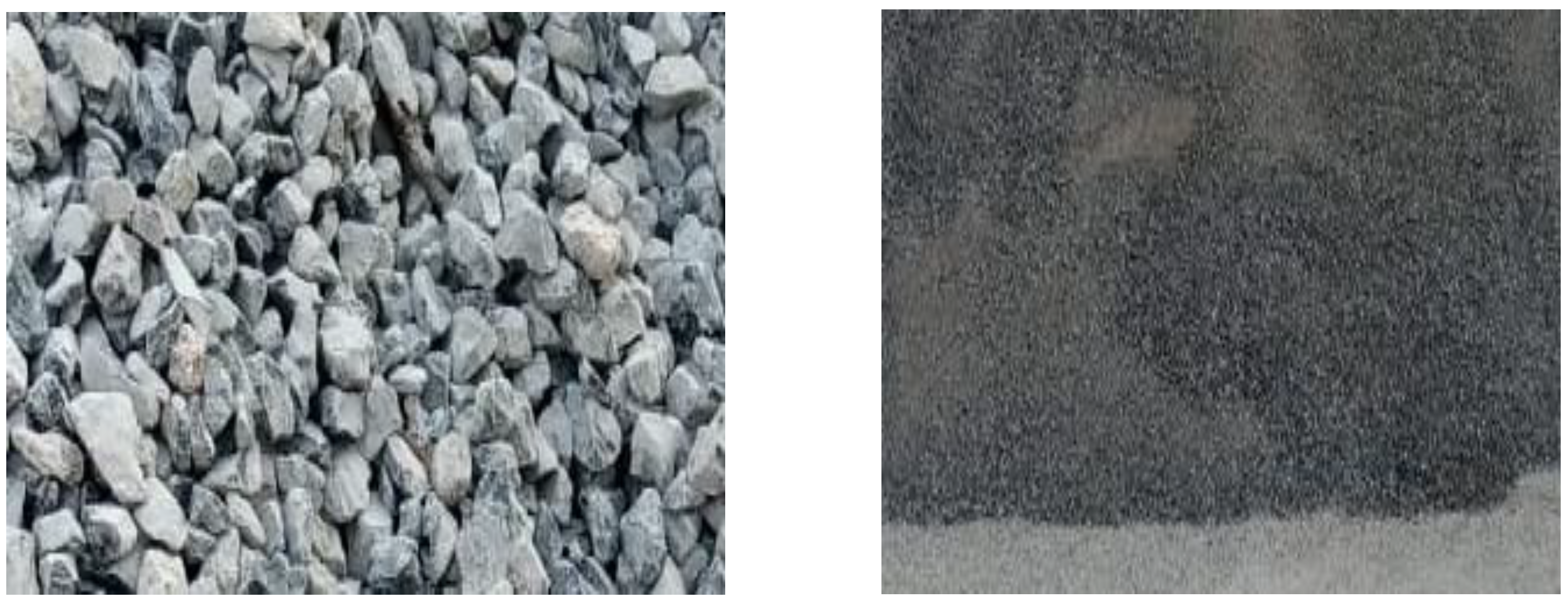

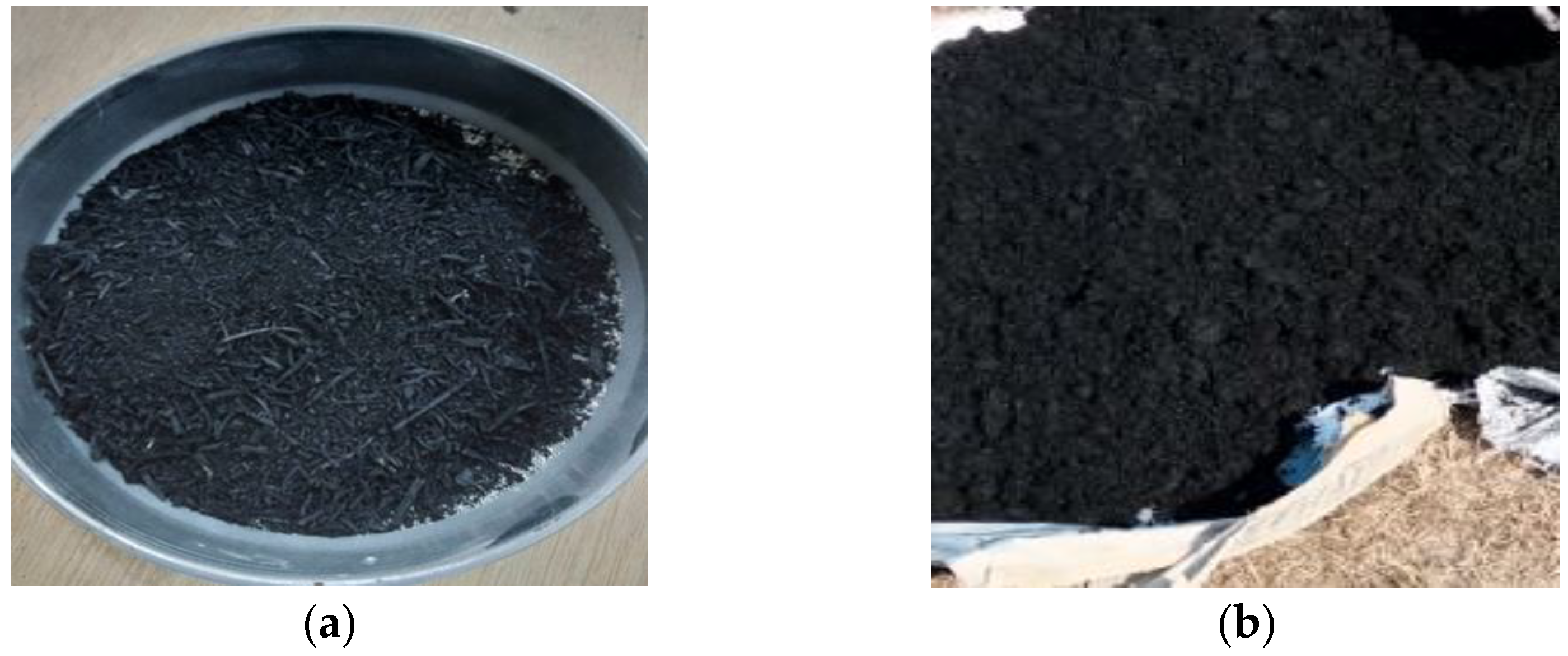
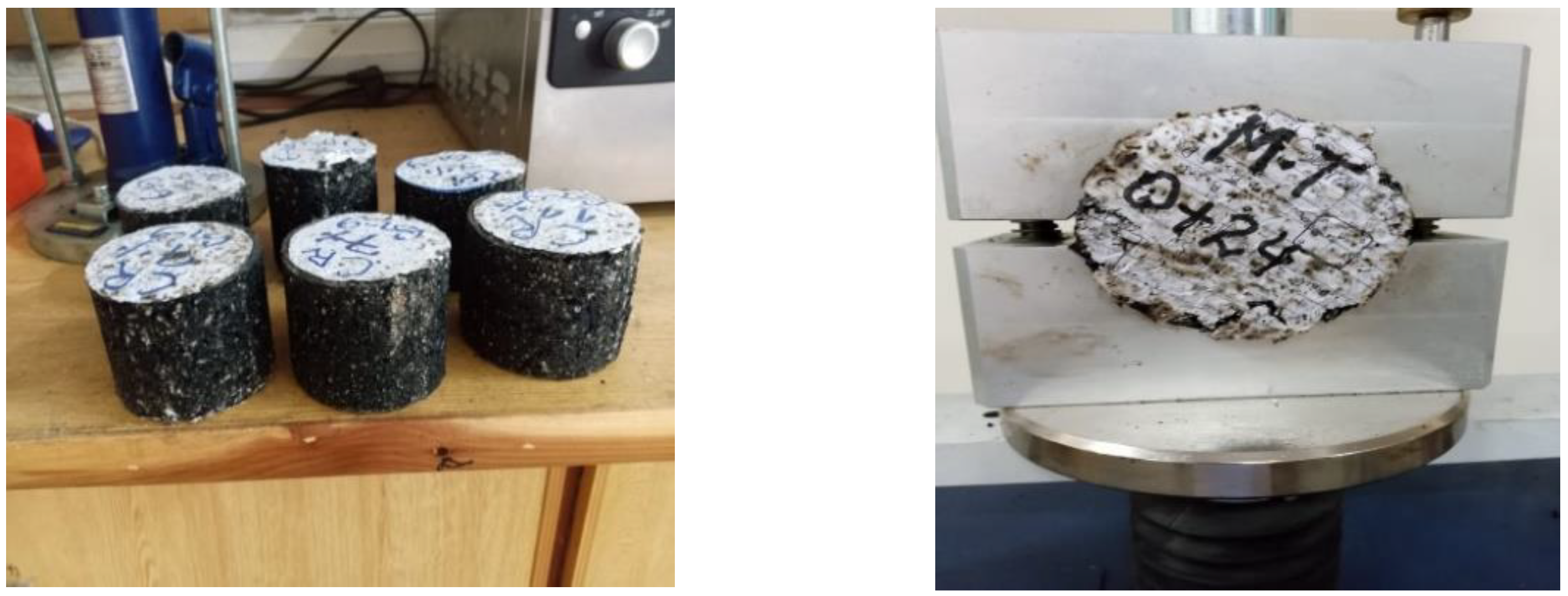
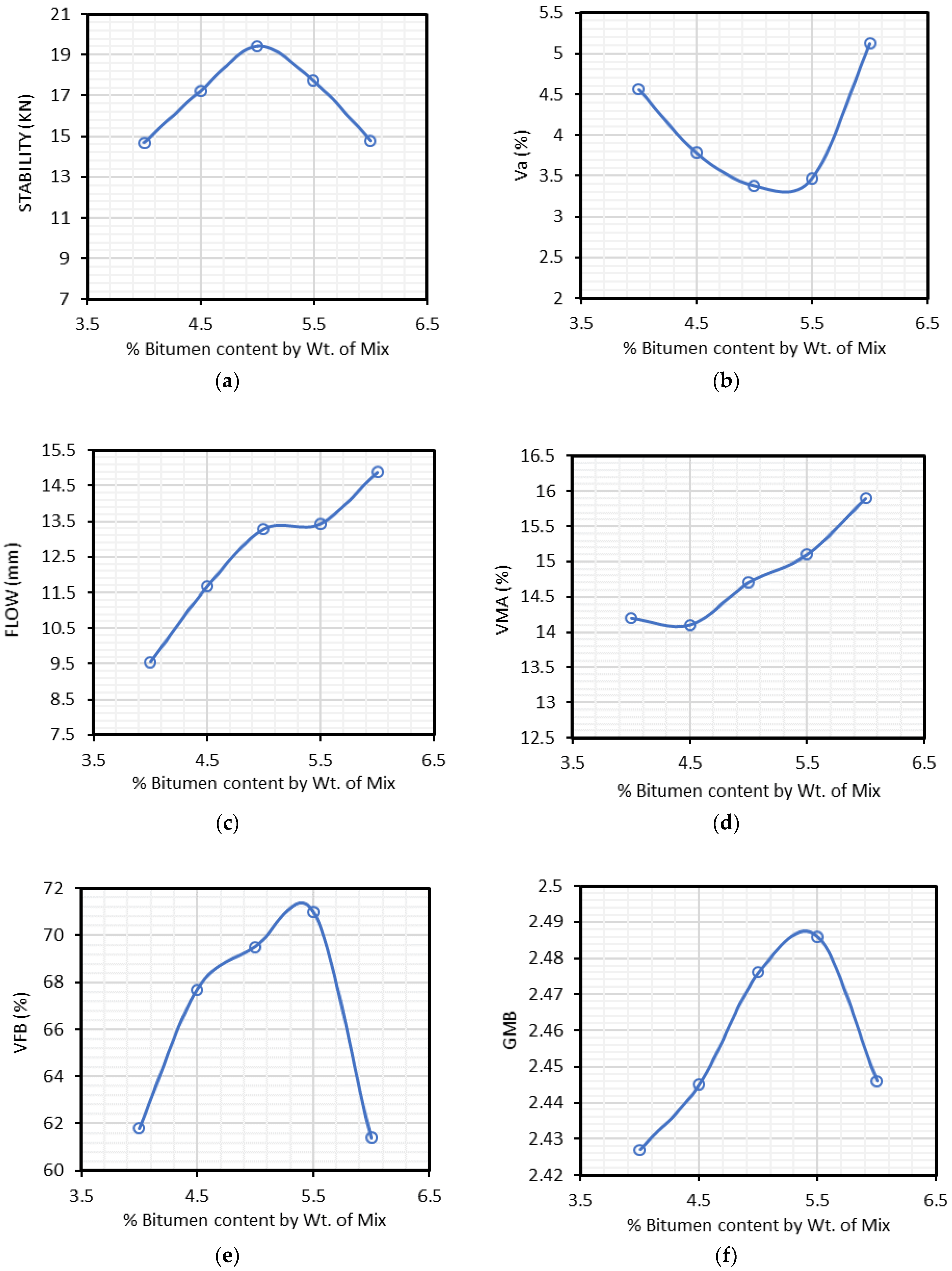
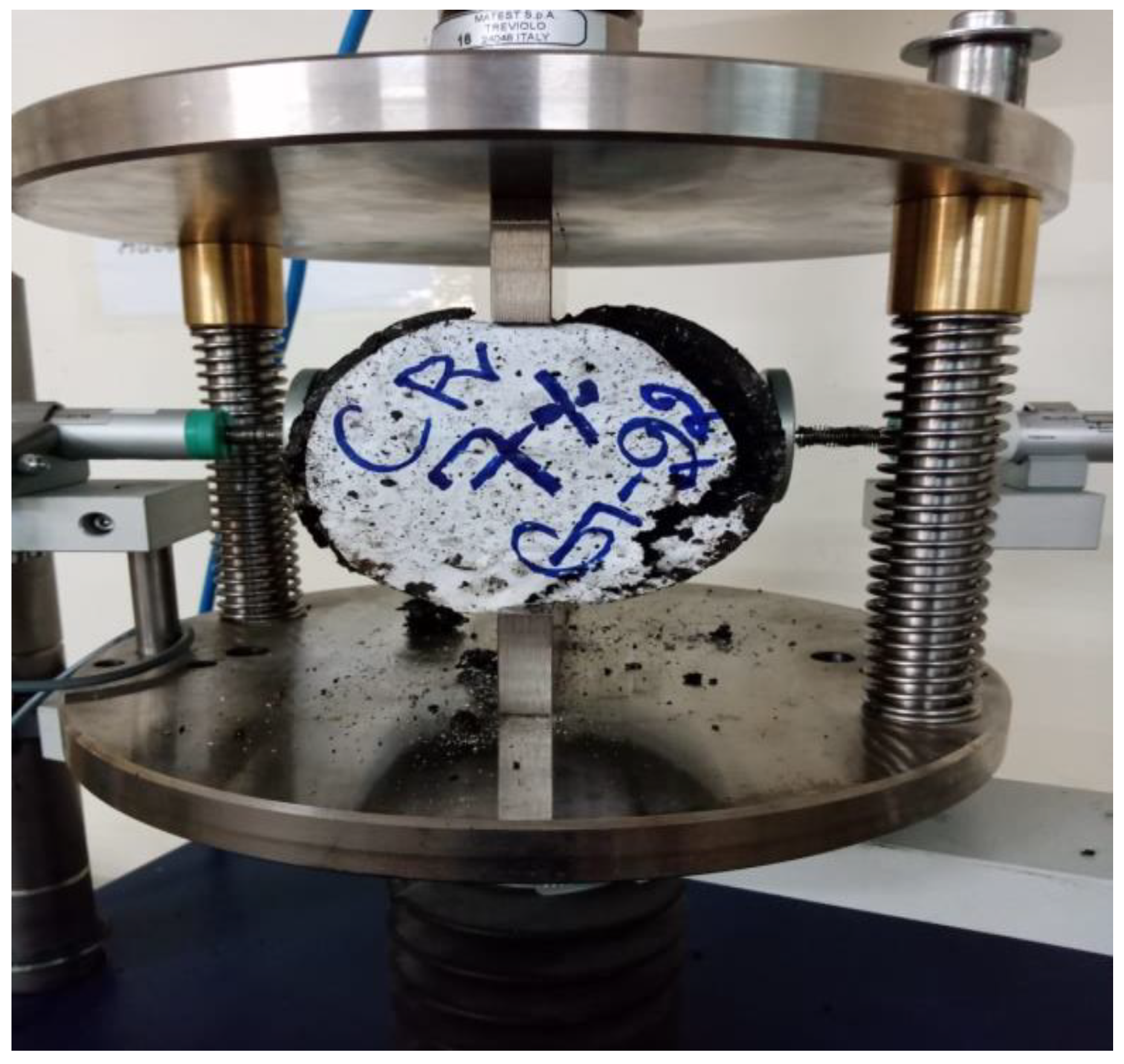
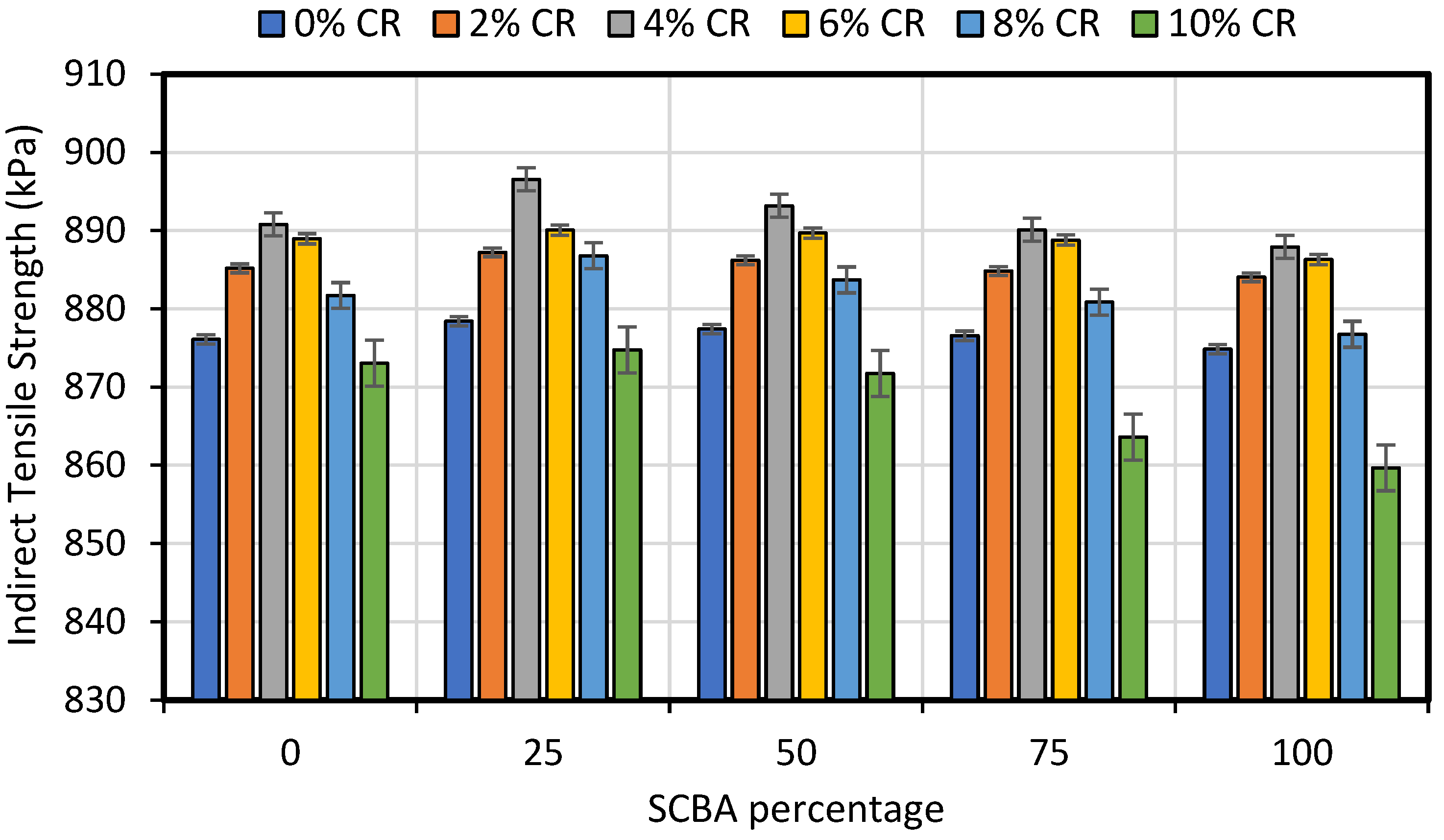


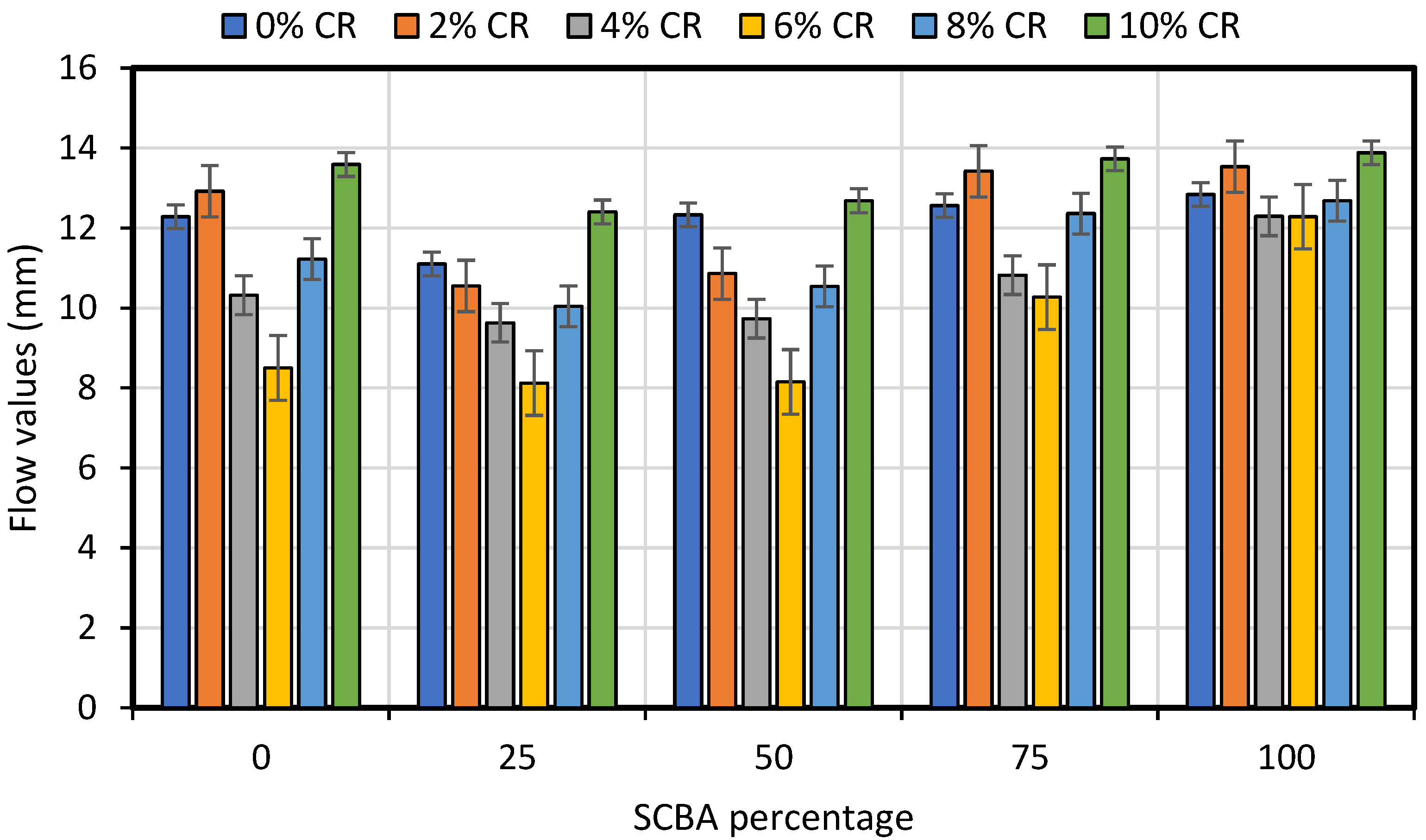
| Aggregate Tests | ASTM Standards | Specification Limits | Results |
|---|---|---|---|
| Specific gravity | ASTM C127 [47] | – | 2.68 |
| Los Angeles abrasion (%) | ASTM C131 [48] | <30% | 20.43 |
| Impact value (%) | ASTM D 5874-95 [49] | <30% | 15.12 |
| Water absorption (%) | ASTM C128 [47] | – | 0.5 |
| Flakiness (%) | ASTM D 4791-99 [50] | 10% | 7.45 |
| Elongation (%) | ASTM D 4791-99 [50] | 10% | 6.34 |
| Bitumen Tests | ASTM Standards | Specification Limits | Results |
|---|---|---|---|
| Softening Point | ASTM D36-95 [51] | 48–56 °C | 53 °C |
| Ductility | ASTM D113-86 [52] | min 100 cm | 109 cm |
| Penetration | ASTM D5-97 [53] | 60–70 MM | 66.53 mm |
| Flash Point | ASTM D92 [54] | min 232 °C | 279 °C |
| Fire Point | ASTM D92 [54] | min 242 °C | 284 °C |
| Specific Gravity | ASTM D70 [55] | 1.01–1.06 | 1.04 |
| Material | Weight (%) |
|---|---|
| Rubber Hydrocarbons | 45.2 |
| Carbon black | 25.8 |
| Acetone Extract | 14.2 |
| Isoprene | 12.1 |
| Water | 0.8 |
| Ash content | 0.9 |
| Fiber content | 0.5 |
| Metal Content | 0.08 |
| Others | 0.42 |
| Oxides, wt% | |
|---|---|
| SiO2 | 66.70 |
| Al2O3 | 9.24 |
| Fe2O3 | 1.53 |
| CaO | 10.07 |
| MgO | 4.60 |
| MnO | 0.05 |
| Na2O | 1.30 |
| K2O | 2.51 |
| TiO2 | 0.25 |
| P2O5 | 1.55 |
| LOI | 2.21 |
| Mix Designation | NHA Class A | |
|---|---|---|
| Compacted thickness | 50–80 mm | |
| mm | in | Percent Passing by Weight |
| 25 | 1 | 100 |
| 19 | 3/4 | 90–100 |
| 13 | 1/2 | – |
| 10 | 3/8 | 56–70 |
| 5 | No. 4 | 35–50 |
| 2 | No. 8 | 23–35 |
| 1 | No. 16 | 5–12 |
| 0 | No. 200 | 2–8 |
| Asphalt Content by Weight | ||
| Percentage of total mix | 3.5 (Min) | |
| Description | NHA General Specification, 1998 |
|---|---|
| Compaction blows | 75 |
| Stability (kg) | 1000 (Minimum) |
| Flow (0.01 inch) | 8–14 |
| VMA | >13 |
| VFB | 70–90 |
| Parameter | % Bitumen Content |
|---|---|
| Bitumen content at the highest stability | 4.5% |
| Bitumen content at the highest value of bulk specific gravity | 4.5% |
| Bitumen content at the median of allowed percentages of air voids | 5.0% |
| Effective Bitumen Content (EBC)—Mean Value | 4.7% |
Publisher’s Note: MDPI stays neutral with regard to jurisdictional claims in published maps and institutional affiliations. |
© 2022 by the authors. Licensee MDPI, Basel, Switzerland. This article is an open access article distributed under the terms and conditions of the Creative Commons Attribution (CC BY) license (https://creativecommons.org/licenses/by/4.0/).
Share and Cite
Ullah, S.; Shah, M.I.; Alqurashi, M.; Javed, M.F.; Dawood, O.; Aslam, F.; Tariq, M.A.U.R.; Hussain, E.E. Eco-Friendly Incorporation of Crumb Rubber and Waste Bagasse Ash in Bituminous Concrete Mix. Materials 2022, 15, 2509. https://doi.org/10.3390/ma15072509
Ullah S, Shah MI, Alqurashi M, Javed MF, Dawood O, Aslam F, Tariq MAUR, Hussain EE. Eco-Friendly Incorporation of Crumb Rubber and Waste Bagasse Ash in Bituminous Concrete Mix. Materials. 2022; 15(7):2509. https://doi.org/10.3390/ma15072509
Chicago/Turabian StyleUllah, Sheraz, Muhammad Izhar Shah, Muwaffaq Alqurashi, Muhammad Faisal Javed, Osama Dawood, Fahid Aslam, Muhammad Atiq Ur Rehman Tariq, and Enas E. Hussain. 2022. "Eco-Friendly Incorporation of Crumb Rubber and Waste Bagasse Ash in Bituminous Concrete Mix" Materials 15, no. 7: 2509. https://doi.org/10.3390/ma15072509
APA StyleUllah, S., Shah, M. I., Alqurashi, M., Javed, M. F., Dawood, O., Aslam, F., Tariq, M. A. U. R., & Hussain, E. E. (2022). Eco-Friendly Incorporation of Crumb Rubber and Waste Bagasse Ash in Bituminous Concrete Mix. Materials, 15(7), 2509. https://doi.org/10.3390/ma15072509










